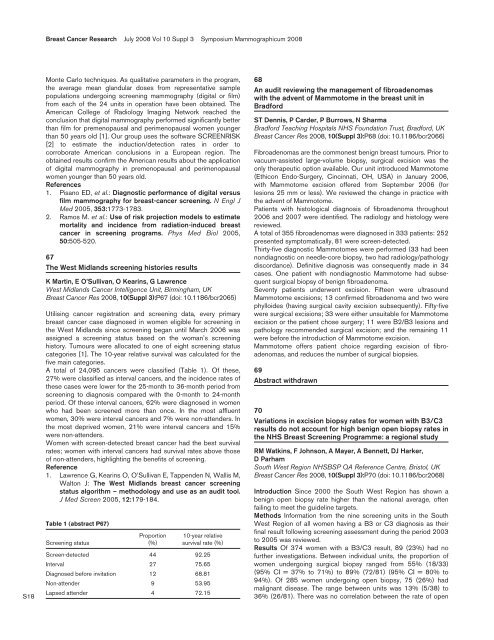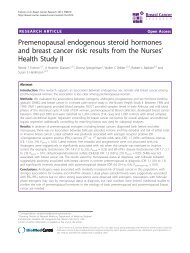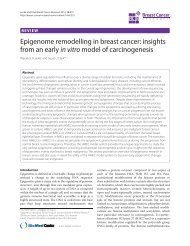Ultrasound-guided axillary node core biopsy - Breast Cancer ...
Ultrasound-guided axillary node core biopsy - Breast Cancer ...
Ultrasound-guided axillary node core biopsy - Breast Cancer ...
Create successful ePaper yourself
Turn your PDF publications into a flip-book with our unique Google optimized e-Paper software.
<strong>Breast</strong> <strong>Cancer</strong> Research July 2008 Vol 10 Suppl 3 Symposium Mammographicum 2008<br />
S18<br />
Monte Carlo techniques. As qualitative parameters in the program,<br />
the average mean glandular doses from representative sample<br />
populations undergoing screening mammography (digital or film)<br />
from each of the 24 units in operation have been obtained. The<br />
American College of Radiology Imaging Network reached the<br />
conclusion that digital mammography performed significantly better<br />
than film for premenopausal and perimenopausal women younger<br />
than 50 years old [1]. Our group uses the software SCREENRISK<br />
[2] to estimate the induction/detection rates in order to<br />
corroborate American conclusions in a European region. The<br />
obtained results confirm the American results about the application<br />
of digital mammography in premenopausal and perimenopausal<br />
women younger than 50 years old.<br />
References<br />
1. Pisano ED, et al.: Diagnostic performance of digital versus<br />
film mammography for breast-cancer screening. N Engl J<br />
Med 2005, 353:1773-1783.<br />
2. Ramos M. et al.: Use of risk projection models to estimate<br />
mortality and incidence from radiation-induced breast<br />
cancer in screening programs. Phys Med Biol 2005,<br />
50:505-520.<br />
67<br />
The West Midlands screening histories results<br />
K Martin, E O’Sullivan, O Kearins, G Lawrence<br />
West Midlands <strong>Cancer</strong> Intelligence Unit, Birmingham, UK<br />
<strong>Breast</strong> <strong>Cancer</strong> Res 2008, 10(Suppl 3):P67 (doi: 10.1186/bcr2065)<br />
Utilising cancer registration and screening data, every primary<br />
breast cancer case diagnosed in women eligible for screening in<br />
the West Midlands since screening began until March 2006 was<br />
assigned a screening status based on the woman’s screening<br />
history. Tumours were allocated to one of eight screening status<br />
categories [1]. The 10-year relative survival was calculated for the<br />
five main categories.<br />
A total of 24,095 cancers were classified (Table 1). Of these,<br />
27% were classified as interval cancers, and the incidence rates of<br />
these cases were lower for the 25-month to 36-month period from<br />
screening to diagnosis compared with the 0-month to 24-month<br />
period. Of these interval cancers, 62% were diagnosed in women<br />
who had been screened more than once. In the most affluent<br />
women, 30% were interval cancers and 7% were non-attenders. In<br />
the most deprived women, 21% were interval cancers and 15%<br />
were non-attenders.<br />
Women with screen-detected breast cancer had the best survival<br />
rates; women with interval cancers had survival rates above those<br />
of non-attenders, highlighting the benefits of screening.<br />
Reference<br />
1. Lawrence G, Kearins O, O’Sullivan E, Tappenden N, Wallis M,<br />
Walton J: The West Midlands breast cancer screening<br />
status algorithm – methodology and use as an audit tool.<br />
J Med Screen 2005, 12:179-184.<br />
Table 1 (abstract P67)<br />
Proportion 10-year relative<br />
Screening status (%) survival rate (%)<br />
Screen-detected 44 92.25<br />
Interval 27 75.65<br />
Diagnosed before invitation 12 68.81<br />
Non-attender 9 53.95<br />
Lapsed attender 4 72.15<br />
68<br />
An audit reviewing the management of fibroadenomas<br />
with the advent of Mammotome in the breast unit in<br />
Bradford<br />
ST Dennis, P Carder, P Burrows, N Sharma<br />
Bradford Teaching Hospitals NHS Foundation Trust, Bradford, UK<br />
<strong>Breast</strong> <strong>Cancer</strong> Res 2008, 10(Suppl 3):P68 (doi: 10.1186/bcr2066)<br />
Fibroadenomas are the commonest benign breast tumours. Prior to<br />
vacuum-assisted large-volume <strong>biopsy</strong>, surgical excision was the<br />
only therapeutic option available. Our unit introduced Mammotome<br />
(Ethicon Endo-Surgery, Cincinnati, OH, USA) in January 2006,<br />
with Mammotome excision offered from September 2006 (for<br />
lesions 25 mm or less). We reviewed the change in practice with<br />
the advent of Mammotome.<br />
Patients with histological diagnosis of fibroadenoma throughout<br />
2006 and 2007 were identified. The radiology and histology were<br />
reviewed.<br />
A total of 355 fibroadenomas were diagnosed in 333 patients: 252<br />
presented symptomatically, 81 were screen-detected.<br />
Thirty-five diagnostic Mammotomes were performed (33 had been<br />
nondiagnostic on needle-<strong>core</strong> <strong>biopsy</strong>, two had radiology/pathology<br />
discordance). Definitive diagnosis was consequently made in 34<br />
cases. One patient with nondiagnostic Mammotome had subsequent<br />
surgical <strong>biopsy</strong> of benign fibroadenoma.<br />
Seventy patients underwent excision. Fifteen were ultrasound<br />
Mammotome excisions; 13 confirmed fibroadenoma and two were<br />
phylloides (having surgical cavity excision subsequently). Fifty-five<br />
were surgical excisions; 33 were either unsuitable for Mammotome<br />
excision or the patient chose surgery; 11 were B2/B3 lesions and<br />
pathology recommended surgical excision; and the remaining 11<br />
were before the introduction of Mammotome excision.<br />
Mammotome offers patient choice regarding excision of fibroadenomas,<br />
and reduces the number of surgical biopsies.<br />
69<br />
Abstract withdrawn<br />
70<br />
Variations in excision <strong>biopsy</strong> rates for women with B3/C3<br />
results do not account for high benign open <strong>biopsy</strong> rates in<br />
the NHS <strong>Breast</strong> Screening Programme: a regional study<br />
RM Watkins, F Johnson, A Mayer, A Bennett, DJ Harker,<br />
D Parham<br />
South West Region NHSBSP QA Reference Centre, Bristol, UK<br />
<strong>Breast</strong> <strong>Cancer</strong> Res 2008, 10(Suppl 3):P70 (doi: 10.1186/bcr2068)<br />
Introduction Since 2000 the South West Region has shown a<br />
benign open <strong>biopsy</strong> rate higher than the national average, often<br />
failing to meet the guideline targets.<br />
Methods Information from the nine screening units in the South<br />
West Region of all women having a B3 or C3 diagnosis as their<br />
final result following screening assessment during the period 2003<br />
to 2005 was reviewed.<br />
Results Of 374 women with a B3/C3 result, 89 (23%) had no<br />
further investigations. Between individual units, the proportion of<br />
women undergoing surgical <strong>biopsy</strong> ranged from 55% (18/33)<br />
(95% CI = 37% to 71%) to 89% (72/81) (95% CI = 80% to<br />
94%). Of 285 women undergoing open <strong>biopsy</strong>, 75 (26%) had<br />
malignant disease. The range between units was 13% (5/38) to<br />
36% (26/81). There was no correlation between the rate of open






